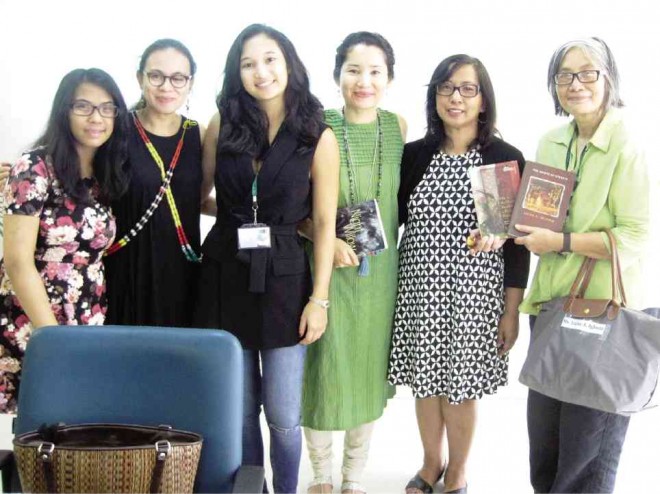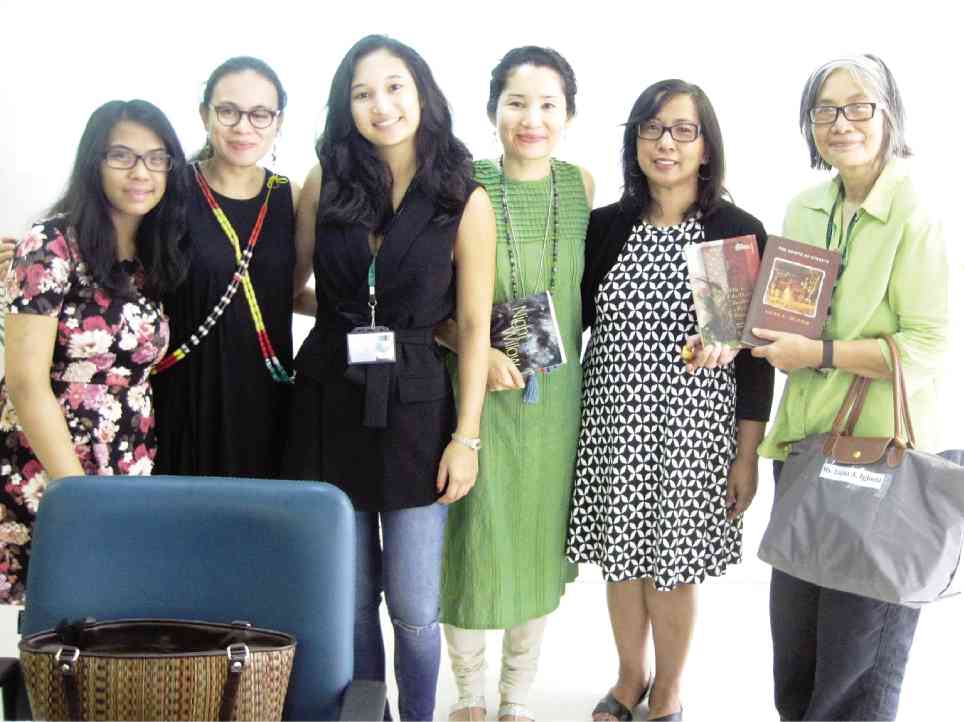
To Luisa A. Igloria, prolific poet who traces her roots proudly to Baguio City and who has been away from the country for 16 years, her homecoming in July meant revisiting simple pleasures. “Oh! The joy of fresh buko again. And mountain rice every day. And barako coffee every morning,” she exclaimed.
Who is Igloria that she has inspired such extremes as worshipful admiration from her former University of the Philippines Baguio and De La Salle University (DLSU) students, but envy or disdain from those who think, as she put it bluntly, that she once was “the Scarlet Woman of Baguio” for leaving a marriage that was starting to unravel before she went on a Fulbright scholarship to the University of Illinois in Chicago in ’92?
She has since remarried, carved out a career as a creative writing professor at the Old Dominion University in Norfolk, Virginia, bore a fourth daughter, Gabriela, who was with her on this visit.
Mysterious
Poet-teacher Mookie Katigbak-Lacuesta described Igloria this way: “To an entire generation of writers beginning their writing lives in the late ’90s and early 2000s, Luisa Igloria was everything a writer should be: decorated, unattainable and mysterious.
“When my generation came of age, Luisa had just left for United States where she would pursue a successful career in writing—her bibliography grows every year, and so, too, do the honors and awards. The list goes on, and it reads like Woody Allen’s prodigious filmography.”
She continued: “Back then, all that we had to go on were the Palanca archives, a volume called ‘Blood Sacrifice’ and sundry poems published in Clinton Palanca’s superb survey of local literature, ‘Pen and Ink.’
“The poems were tender, tough, lyrical and unlike any of the stiff templates we were taught to reproduce so that we might write good poetry. We were unused to the brazen forthrightness of such confessional work. We thrilled to such lines as: ‘Desire is its own/ Unpredictable science/ Demanding pursuit of its/ inventions, the nautilus/ And compass of its tropes/ You take it to your lips; / You marry it, embrace it, / Admitting the simple longing / That ripens / Into this loss.’”
Lusty parts
The books were what her generation of writers read in their own time. She challenged the audience at the DLSU lecture to ask “which book we had dog-eared to the lusty parts, which book spine had to be done over with two layers of masking tape because it had been splayed too often on school desks or bedtime tables, and the answer would be ‘Blood Sacrifice.’ Our favorite writer belonged to no cadre or coterie, did not belong to the unfashionable noun known as the ‘establishment,’ and yet this was a writer whose influence you could not overlook in many of our early verses.”
The lesson she learned was: “A writer writes, never mind where, or for whom, or for what. It was this unspoken credo that accounted for some of the most beautiful poetry we were reading at that time.”
In her author talk, Igloria acknowledged the audience as part of the world that is “passionate about poetry and believe in its potential to change and deepen our experience of living in the world.”
She spoke about bringing back the sense of play in studying and teaching literature. She said she is often asked, “how to sustain and nourish the creative energy for writing [in other words, how not to get stuck]. Speaking just for myself, however, there are a few things I’ve come to realize—one is the absolute importance of returning to a sense of play (of pleasure, spontaneity, and enjoyment) in writing.”
She said, “I think of that scene in ‘The Shining’ when Wendy Torrance creeps down the hotel stairs to Jack’s typewriter and discovers that the only ‘writing’ he has managed is reams of paper with one sentence—‘All work and no play makes Jack a dull boy’—typed over and over. I suspect that’s what writers are most afraid of: when the enterprise of writing becomes too driven by the engine of labor, or so grim and joyless that it truly becomes a monster to be feared.”

Delgado, Luisa and the author
Heat of idea
She continued, “We create best when we’re in that space where it seems time and judgment are suspended; when the material and the aerial seem to braid; when it doesn’t even occur to us to think of what readers or critics might say; when all that matters in that moment is that we follow the heat of the idea, image, feeling or insight, arcing over previously untenanted space.”
She confessed to not wanting “to turn into Jack Torrance.”
To do this she has looked for ways “to enliven and sustain my writing practice. My goal is not perfection(ism) but rather the cultivation of a lifelong ability to keep my senses open, to focus my sensibility and attention and to be excited by the opportunity that the page signifies.”
To stay sharp and sensitive, she writes at least one poem a day, a practice she has been doing since Nov. 20, 2010. These poems are posted on Dave Bonta’s Via Negativa website.
One poem a day? Of the practice she once wrote: “Not only has ‘running with my muse’ daily made me more limber and given me much valuable biofeedback about my writing, it has also taught me many lessons about fear and anxiety, my habits [both good and bad], the many little [and big] excuses that the self seems to conveniently find when confronted with things it is afraid of and/or that must get done.”
To her own questions on what draws anyone to writing poetry, what draws her to this discipline which she has “come to love so much” that she cannot imagine going a day without writing a poem, she said, “Besides the sound and music of poetry, part of what keeps bringing me back is the aspiration of trying to live, really live, in better sympathy with myself and others and with the world—how to imbue my ordinary life with what I hope becomes a growing awareness of itself, how to cultivate a more living attention to every surface: smooth or speckled, rough or plain, fraught or blessed with ease.”
She spoke of the poet’s role: “We are taught that at the heart of every experience offered through poetry is one requirement: that we try to imagine what it’s like to live in another’s skin, what it’s like to experience the world seen through another’s eyes. In this way, poetry is marked by its supreme engagement with making pathways of authentic connection…”
She quoted poet Mary Ruefle who wrote, “Everything depends on the poem, not me.” To Igloria this means “we are never completely in charge of the conditions of its making, never completely able to dictate the moment when all the poem’s elements bind together in a fusion that perhaps can only be described as mystery.”
Storytelling
For children and youth to cherish The Word, she recommends storytelling, not just reading aloud.
She recalled her own Baguio childhood where her mom, the educator Zosima Aguilar, read stories and poems at bedtime from the Little Golden Books, “Palgrave’s Golden Treasury,” Philippine folk tales, fairy tales (Andersen and Grimm), Bulfinch’s mythology, among many.
Young Luisa would, at the end of every nightly selection, “always beg for more, so much so that she grew tired of having to get up and search for another book. Instead, she began making up stories: at first, stories she knew from other sources, or stories she might have heard growing up; then, stories of real people she knew during the war, during the Japanese occupation of the Philippines, when she was a little girl and her mother had died; stories of friends or relatives that I never met because they had long passed before I ever came to be, and that I knew by the old-fashioned feel of their names in my mouth— Filomena, Lorenzo, Victoria, Conchita. Who knows where the real left off and the imagined began?
“Nevertheless, she wove them into a patchwork, turning them into something entirely new. Lying next to me in bed and narrating them in my ear, she’d pause to consider and improvise. When the pauses grew too pointed, I would prompt her impatiently: And then? And then?
“And then she would be forced to take up the thread… But rather than encourage sleep, these exercises in spontaneous storytelling instantly pulled me back to awareness: now I wanted to know what might really be coming next or how it related to what I’d heard a few moments before…”
Igloria concluded that improvisation, curiosity, invention, experiment helped in the shaping of a poet: “When children are playing in an empty lot, they might find stones and grass, dangerous bits of broken glass, sparkly pebbles, a piece of barbed wire, a tin can. They might gather them or line them up, rename and repurpose them, declare dramatic scenarios, invent the laws and logic that apply to these objects.
“Writing, I want to feel that I can begin from a similar place—close to the ground or in the mud, where I can put one thing that I’ve found next to another to see: What if? So then, anything can be a prompt or a trigger—it is the mind’s veering and suggestive tilting of what it finds toward other meanings and connections [other than those that are givens] that seems the most fertile for poetry.”
We asked her what she felt upon returning to Baguio after a long spell.
She replied, “It’s hard to put into words what I felt at coming home again after 16 long years and not seeing in as long a time my eldest daughter Jenny in the flesh. It was also the first time that Jenny and Gabriela, my oldest and youngest, met in person and could hug each other, laugh, interact and tell stories in the same physical space—not just through text or Google hangouts or Skype.”
She continued, “My mom, now 81, came and visited us 10 years ago, when Gabriela was only four. That too is a long spell of time. The emotional impact of this reunion with both my mom, my daughter and my half siblings will stay with me for a very long time. I’m glad to know and to have seen with my own eyes that my mom is still strong and energetic, that she is still sharp and doesn’t lose a beat, but it also pained me to see that she is also aging.”
Urban blight
About Baguio’s near ruination by developers and some corrupt city officials, she said, “I was saddened by the urban blight, the choking traffic, the seeming lack of breathing spaces in the Baguio of today.
“When I visited with dear high school friend Mita Dimalanta at the Baguio Country Club, looking out over the grounds it seemed that was the only little spot of scenery that resembled the Baguio that we knew in our childhoods. The torrential rains—two straight weeks of monsoon while we were there—may also have influenced my impressions during this return. By itself, I could handle the rain since we know Baguio has always been like that. It’s the sad state of what you refer to as its ‘ruination’ that makes me grieve, the unceasing ‘development’ and all sorts of construction projects pointed out to me by my eldest daughter, in anticipation of the election year, do not help but instead contribute to its decline.”
But return she, Gabriela and perhaps her husband Ruben will.
Poet Luisa A. Igloria is the author of “Bright as Mirrors Left in the Grass” (Kudzu House Press eChapbook selection for Spring 2015), “Ode to the Heart Smaller than a Pencil Eraser” (Utah State University Press, 2014, May Swenson Prize), “Night Willow” (Phoenicia Publishing, 2014), “The Saints of Streets” (University of Santo Tomas Publishing House, 2013), “Juan Luna’s Revolver” (University of Notre Dame Press, 2009 Ernest Sandeen Prize), “Trill and Mordent” (WordTech Editions, 2005) and eight other books.
When she isn’t writing, reading, or teaching, she cooks with her family, hand-binds books, listens to tango music and keeps her radar tuned for cool lizard sightings. Her other books published in the Philippines are available at bigger bookstores and Mt. Cloud Bookshop in Baguio City.









































